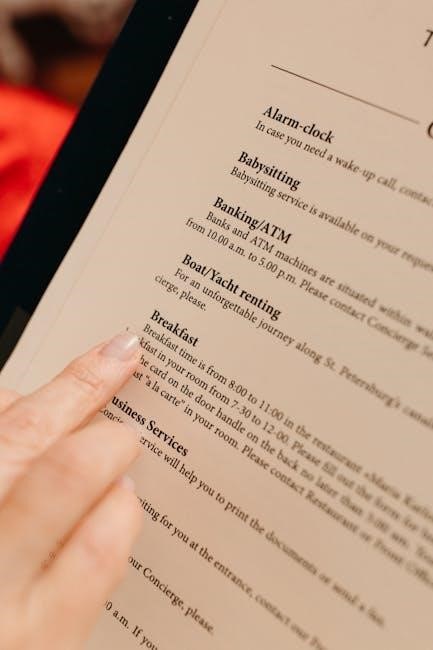Adjectives are descriptive words that modify nouns or pronouns, enhancing language clarity and expression. They play a crucial role in conveying detailed information about people, places, and things.
1.1 What Are Adjectives?
Adjectives are words that describe or modify nouns or pronouns, providing more information about their qualities, such as size, color, shape, or emotion. For example, in the sentence “a beautiful sunset,” the adjective “beautiful” describes the noun “sunset.” Adjectives help clarify and specify the characteristics of a person, place, thing, or idea, making language more vivid and precise. They can appear before the noun they describe or after a linking verb, enhancing the meaning of a sentence and helping to create clearer imagery in communication.
1.2 Importance of Adjectives in Language
Adjectives are essential for adding detail and depth to language, making communication more vivid and precise. They help describe the qualities of nouns, such as size, color, or emotion, enhancing clarity. By using adjectives, speakers and writers can convey their intended meaning more effectively, engaging their audience and painting a clearer picture. In both written and spoken language, adjectives are vital for expressing nuances, making ideas more relatable, and fostering better understanding. Their presence enriches conversations and written content, ensuring messages are conveyed with accuracy and impact.
1.3 Why Use a List of Adjectives?
A list of adjectives is a valuable resource for enhancing vocabulary and improving communication skills. It provides a quick reference for descriptive words, helping to expand language use in both writing and speaking. Whether for learning, teaching, or everyday use, a structured list of adjectives ensures easy access to the right words. It also aids in organizing ideas, making it simpler to convey thoughts effectively; By using a list of adjectives, individuals can refine their expressions, add clarity to sentences, and enhance their overall linguistic abilities. This tool is particularly useful for learners and educators alike.

Structure of the Adjective List PDF
The PDF is a structured guide, categorizing adjectives into basic, descriptive, quantitative, and demonstrative types. It provides a user-friendly format with clear examples and usage tips.
2.1 Basic Adjectives
Basic adjectives are simple words that describe the fundamental qualities of nouns. Examples include big, red, and happy. These adjectives are foundational, providing clear, direct descriptions. They are essential for effective communication, helping to identify or quantify nouns. Basic adjectives are often the first adjectives learners encounter, as they form the building blocks of descriptive language. The PDF organizes these adjectives in a straightforward manner, making them easy to understand and use in everyday sentences. They are versatile and can describe size, color, emotion, and more, serving as a starting point for expanding vocabulary and improving language skills.
2.2 Descriptive Adjectives
Descriptive adjectives provide detailed information about nouns, enhancing imagery and understanding. They describe characteristics such as appearance, texture, size, color, or condition. Examples include vibrant, smooth, and enchanting. These adjectives add depth to language, making descriptions more vivid and engaging. The PDF categorizes descriptive adjectives to help learners easily identify and use them effectively. By incorporating these adjectives, speakers and writers can create more evocative and precise expressions, improving overall communication. This section focuses on adjectives that paint a clear picture, making language more expressive and dynamic.
2.3 Quantitative Adjectives
Quantitative adjectives describe the quantity, number, or extent of a noun. They express how much or how many of something exists. Examples include three, many, much, few, little, each, every, some, any, enough, half, both, several, numerous, countless, and dozen. These adjectives help specify or generalize amounts, making communication more precise. The PDF organizes quantitative adjectives to simplify learning and usage. Mastering these adjectives enhances clarity and effectiveness in expressing ideas, whether in writing or speech.
2.4 Demonstrative Adjectives
Demonstrative adjectives identify specific nouns by pointing out which one is being referred to. Common examples include this, that, these, and those. These adjectives clarify which person, place, or thing is being discussed, providing context and reducing ambiguity. For instance, this book refers to a specific book nearby, while that book refers to one farther away. The PDF includes a detailed list of demonstrative adjectives, along with examples, to help learners understand their proper usage in sentences. Mastering these adjectives improves communication and precision in language.

Categories of Adjectives
Adjectives are categorized based on the type of information they convey. Common categories include qualitative, quantitative, demonstrative, and interrogative adjectives, each serving distinct purposes in enhancing communication.
3.1 Qualitative Adjectives
Qualitative adjectives describe the qualities or characteristics of nouns, such as color, shape, or condition. They help create vivid imagery by detailing sensory or perceptual attributes. For instance, words like “red,” “smooth,” or “vibrant” convey specific traits, enhancing descriptions. These adjectives are essential for painting clear pictures in writing and speech, making communication more engaging and precise. They allow speakers and writers to express nuanced ideas effectively, adding depth to language. Qualitative adjectives are fundamental in both creative and everyday contexts, enabling rich and detailed expression.
3.2 Quantitative Adjectives
Quantitative adjectives describe the quantity of nouns, indicating how much or how many. They provide numerical or measurable information, such as “five,” “many,” or “little.” These adjectives help specify amounts, making communication more precise. Examples include cardinal numbers like “three” or “hundred,” and words like “few” or “enough.” They are essential for clarifying extent or degree, preventing ambiguity. Quantitative adjectives are widely used in both spoken and written English to convey clear, measurable details about people, objects, or ideas. They play a vital role in effective communication by adding specificity to descriptions.
3.3 Demonstrative Adjectives
Demonstrative adjectives, such as “this,” “that,” “these,” and “those,” specify which noun is being referred to; They indicate proximity or distance, helping to clarify meaning. For example, “This book is mine” points to a specific item. They are essential for clear communication, especially when distinguishing between similar objects. Demonstrative adjectives are often used in both spoken and written English to avoid ambiguity. They provide precision by identifying which thing is being discussed, making sentences more informative and contextually clear. Mastering these adjectives enhances communication effectiveness and reduces confusion in conversations or texts.
3.4 Interrogative Adjectives
Interrogative adjectives, such as “what,” “which,” and “whose,” are used to form questions. They modify nouns and help seek specific information. For example, “What book are you reading?” uses “what” to ask about the noun “book.” These adjectives are essential in both spoken and written language for clarifying details. They help in gathering precise information by targeting specific attributes of a noun. Interrogative adjectives are versatile and often used in everyday conversations to inquire about choices or identities. They play a key role in effective communication by enabling clear and direct questioning.

Common Adjectives in English
Common adjectives describe frequent qualities like size, color, or emotion. They are essential for clear communication and often appear in daily language to add detail and context.
4.1 Most Frequently Used Adjectives
The most frequently used adjectives in English include words like big, small, happy, new, good, and great. These adjectives are essential for basic communication and appear regularly in everyday language. They describe common qualities such as size, emotion, and evaluation. Mastering these high-frequency adjectives is crucial for learners, as they form the foundation of descriptive language. Using them correctly enhances clarity and expression in both spoken and written contexts. They are also versatile, fitting into various sentences to convey simple yet meaningful descriptions. A well-organized list of these adjectives can help learners memorize and use them effectively.
4.2 Adjectives for Personality Traits
Adjectives for personality traits describe the characteristics of a person’s behavior, attitude, or demeanor. Common examples include kind, outgoing, shy, confident, honest, creative, and ambitious. These adjectives help convey the essence of someone’s character, making descriptions more vivid and relatable. They are widely used in both spoken and written communication to paint a clear picture of an individual’s traits. Learning these adjectives is essential for expressing opinions about people effectively. They also enable nuanced descriptions, allowing for a deeper understanding of personality. A well-curated list of these adjectives can enhance communication and storytelling skills.
4.3 Adjectives for Physical Description
Adjectives for physical description define the outward appearance of people, animals, or objects. Common examples include tall, short, slim, blonde, brown-eyed, wrinkled, and muscular. These adjectives help paint vivid images, making descriptions more engaging and specific. They are widely used in both spoken and written language to convey details about height, weight, color, and other visible features. Learning these adjectives enhances the ability to describe others accurately. They also play a key role in storytelling and characterization, allowing for clearer mental imagery. A well-organized list of these adjectives can simplify the process of describing physical traits effectively.
4.4 Adjectives for Emotions and Feelings
Adjectives for emotions and feelings describe emotional states, such as happy, sad, angry, excited, calm, and worried. These words convey the inner experiences of individuals, making communication more expressive. They are essential for understanding and sharing emotions, fostering empathy and connection. Examples include joyful, frustrated, grateful, and hopeful. Using these adjectives enriches language, allowing for deeper emotional expression in both personal and professional contexts. A well-organized list of emotional adjectives can help learners master the nuances of emotional language, enhancing their ability to articulate feelings accurately and vividly.

Advanced Adjective Usage
Advanced adjective usage involves complex comparisons, irregular forms, and nuanced descriptions. It enhances expressions, allowing for precise and evocative language. Examples include quicker and most interesting.
5;1 Comparative and Superlative Forms
Comparative and superlative forms of adjectives allow for nuanced comparisons. Regular adjectives add -er (e.g., bigger) for comparative and -est (e.g., biggest) for superlative. Irregular adjectives, like good (better, best), follow unique patterns. These forms are essential for expressing degrees of qualities, enabling precise communication. Correct usage enhances clarity and sophistication in language, while errors can lead to confusion. Examples include quieter and loudest. Mastering these forms is key to advanced adjective usage in both spoken and written English.
5.2 Irregular Adjectives
Irregular adjectives do not follow standard comparative and superlative patterns. Instead, they have unique forms that must be memorized. For example, good becomes better (comparative) and best (superlative), while far becomes farther or further (comparative) and farthest or furthest (superlative). These exceptions can be challenging for learners but are essential for accurate communication. Understanding irregular adjectives enhances vocabulary and improves the precision of language use in both writing and conversation.
5.3 Double Comparatives and Superlatives
Double comparatives and superlatives occur when two adjectives modify the same noun, each in its comparative or superlative form. For example, the tallest and most interesting building uses both a superlative and a comparative form. This construction emphasizes multiple qualities, but it must be structured correctly to avoid confusion. Proper punctuation, such as using commas to separate the adjectives, is essential. Mastering double comparatives and superlatives enhances expressive writing and speech, allowing for clearer and more nuanced descriptions of people, places, and things.

5.4 Using Adjectives in Sentences
Adjectives add detail and depth to sentences by describing nouns or pronouns. They typically precede the noun, as in the beautiful garden, but can also follow linking verbs, like the room is quiet. Proper placement ensures clarity and avoids confusion. For example, she wore a red dress clearly describes the dress, while she wore a dress red is incorrect. Using adjectives effectively enhances communication, making descriptions vivid and precise. Practice identifying and positioning adjectives correctly to improve both written and spoken language skills, ensuring your message is clear and engaging.

Tips for Using the Adjective List PDF
Maximize the PDF by organizing adjectives thematically, creating flashcards for memorization, and practicing with exercises. Regular review enhances vocabulary retention and improves language proficiency effectively.
6.1 How to Organize the List
Organize your adjective list by categorizing them into themes like emotions, physical traits, or quantities. Alphabetical order is also effective for quick reference. Group similar adjectives together, such as big, large, huge for size. Use headings or sections to separate categories, making it easier to navigate. Highlight frequently used adjectives for priority learning. Include examples or sentences to illustrate usage. Regularly review and update the list to ensure relevance and clarity. This structured approach enhances learning and retention, making your PDF a valuable resource for language development.
6.2Creating Flashcards
6.2 Creating Flashcards
Create flashcards by writing the adjective on one side and its meaning, synonyms, or example sentences on the other. Organize them by category, such as emotions or size, for focused learning. Use color-coded cards to differentiate themes and enhance visual appeal. Include images or diagrams to make the flashcards more engaging. Review the cards regularly, shuffling them to avoid repetition. This method helps reinforce memory and improves retention. You can also use digital tools or apps to create interactive flashcards. Keep the text clear and bold for easy reading, ensuring each card is concise and informative. Regular practice with flashcards will help you master the adjectives effectively.
6.3Practicing with Exercises
6.3 Practicing with Exercises
Practicing with exercises is an effective way to master adjectives. Start with fill-in-the-blank sentences, matching games, and identifying the correct adjective forms. Create short stories or descriptions using a variety of adjectives to enhance your understanding. You can also design interactive activities like quizzes or word games to make learning engaging. Regular practice helps reinforce memory and improves your ability to use adjectives effectively in daily communication. Set aside time each day to engage in these exercises and gradually expand your skills over time. Consistency is key to achieving fluency in using adjectives accurately and confidently.
6.4Using the List for Writing
6.4 Using the List for Writing
Using the list of adjectives for writing enhances the quality of your compositions. Refer to the list to find the perfect words to describe characters, settings, or emotions. It helps you avoid repetition and adds variety to your language. When writing essays, stories, or descriptions, use the adjectives to paint vivid pictures. Practice by substituting bland words with more expressive ones from the list. This habit will improve your writing over time, making it more engaging and detailed. Regularly incorporating the list into your writing routine will refine your style and broaden your creative possibilities.

Common Mistakes with Adjectives
Common mistakes with adjectives often hinder clear communication. Errors like incorrect forms, misuse in sentences, or overuse can confuse meaning. Familiarizing yourself with the list helps prevent these errors and improves language accuracy. Mastering adjectives enhances both written and spoken communication effectively.
7.1Misusing Comparative and Superlative Forms
7.1 Misusing Comparative and Superlative Forms
Misusing comparative and superlative forms is a common error. For example, using “more fast” instead of “faster” or saying “the most unique”, which is often incorrect. Another mistake is using double comparatives, like “more quicker”, or incorrect superlatives with absolute adjectives like “most perfect.” These errors can confuse meaning and make writing or speech less clear. Understanding the correct forms is essential for effective communication. Referencing a list of adjectives can help avoid these mistakes and ensure proper usage in sentences.
7.2Confusing Adjectives and Adverbs
7.2 Confusing Adjectives and Adverbs
Confusing adjectives and adverbs is a frequent mistake, especially with words like “fast” and “fastly.” Adjectives modify nouns, while adverbs modify verbs, adjectives, or other adverbs. For example, “She drives carefully” (adverb) vs. “She is a careful driver” (adjective). Using an adjective in place of an adverb (e.g., “He spoke loud”) or vice versa can lead to grammatical errors. A well-organized list of adjectives can help learners distinguish between these forms and use them correctly in sentences.
7.3Incorrect Placement in Sentences
7.3 Incorrect Placement in Sentences
Incorrectly placing adjectives in sentences can confuse meaning and disrupt clarity. For example, saying “She wears a hat red” instead of “She wears a red hat” changes the sentence structure. Adjectives typically precede the noun they describe, but errors occur when they are misplaced, especially in complex sentences. This mistake can alter the intended meaning and make communication less effective. Learning proper adjective placement is essential for clear and accurate expression. A well-organized list of adjectives can help learners practice correct usage and avoid such errors in their writing and speaking.
7.4Overusing Adjectives
7.4 Overusing Adjectives
Overusing adjectives can make sentences cluttered and less effective. While adjectives add detail, too many can confuse the reader and dilute the intended message. For example, saying “The incredibly beautiful, stunning, and amazing sunset” is redundant, as multiple adjectives describing the same noun lose impact. A well-curated list of adjectives can help learners avoid this mistake by teaching them to choose the most fitting words. Selective use of adjectives enhances clarity and ensures more powerful communication, making writing and speaking more engaging and precise.

Practical Applications of the PDF
This PDF serves as a valuable resource for enhancing vocabulary, improving writing skills, boosting speaking fluency, and preparing for exams with its comprehensive adjective collection.
8.1Enhancing Vocabulary
8.1 Enhancing Vocabulary
The PDF provides a wide range of adjectives, helping learners expand their vocabulary. By studying the list, users can discover new words, understand their meanings, and learn how to use them in context. This resource is particularly useful for non-native speakers aiming to improve their language skills. The organized structure allows for easy navigation, making it simple to focus on specific types of adjectives. Regular review of the list can enhance retention, enabling learners to incorporate more descriptive language into their everyday communication. This tool is essential for anyone looking to enrich their vocabulary and express ideas more effectively.
8.2Improving Writing Skills
8.2 Improving Writing Skills
The list of adjectives PDF is a valuable tool for enhancing writing skills by providing a rich source of descriptive words. It helps writers avoid repetition and adds variety to their language. By incorporating adjectives, writers can create more vivid and engaging descriptions, making their content more appealing to readers. The PDF also offers examples of how adjectives can be used in different contexts, improving clarity and precision in writing. Regular use of this resource can lead to more expressive and impactful writing, helping writers convey their ideas more effectively.
8.3Boosting Speaking Fluency
8.3 Boosting Speaking Fluency
A list of adjectives PDF can significantly enhance speaking fluency by expanding vocabulary and providing descriptive words for everyday conversations. Practicing with the list helps speakers describe people, objects, and situations more accurately. It encourages the use of varied language, making conversations more engaging and expressive. Learners can use the PDF to create flashcards or role-play scenarios, fostering confidence in using adjectives naturally. Regular practice with the list improves the ability to think and articulate ideas quickly, leading to smoother and more fluent speech in both casual and formal settings.
8.4Preparing for Exams
8.4 Preparing for Exams
A list of adjectives PDF is a valuable tool for exam preparation, helping learners expand their vocabulary and improve descriptive writing skills. It provides a quick reference for commonly tested adjectives, ensuring familiarity with words frequently used in exams. Students can practice incorporating these adjectives into sentences, enhancing their ability to express ideas clearly. Regular review of the list boosts confidence and reduces exam anxiety, enabling learners to perform at their best in writing and speaking tasks. It’s an essential resource for achieving success in language-based exams like TOEFL, IELTS, or SAT.
A list of adjectives PDF is a powerful tool for mastering descriptive language, enhancing vocabulary, and improving writing skills. Regular practice ensures confidence and effective communication.
9.1Summary of Key Points
9.1 Summary of Key Points
A list of adjectives PDF is an essential resource for learning and mastering descriptive language. It covers various categories, including qualitative, quantitative, demonstrative, and interrogative adjectives. The PDF provides a structured approach to understanding adjectives, from basic to advanced usage, and offers practical tips for effective learning. Common mistakes and their corrections are highlighted, along with exercises to enhance vocabulary and improve writing and speaking skills. Regular practice with the list ensures better command of adjectives, making communication clearer and more expressive. It’s a valuable tool for learners at all levels.
9.2Encouragement to Practice
9.2 Encouragement to Practice
Consistent practice with the adjective list PDF is key to mastering descriptive language. Regular use enhances vocabulary, improves writing, and boosts speaking confidence. Incorporate adjectives into daily conversations and writings to see progress. Make learning fun by creating sentences or stories using adjectives from the list. Practice exercises and quizzes to reinforce understanding. Over time, this dedication will refine your ability to express ideas vividly and effectively, making communication clearer and more engaging for others.
9.3Final Thoughts on Using the PDF
9.3 Final Thoughts on Using the PDF
The adjective list PDF is a valuable resource for enhancing language skills. It offers a comprehensive guide to understanding and using adjectives effectively. By incorporating this tool into your learning routine, you can expand your vocabulary, refine your expressions, and communicate more clearly. The structured format makes it easy to practice consistently, ensuring steady progress. Whether you’re a student or a professional, this PDF serves as a lifelong resource to improve your command of adjectives and elevate your communication. Embrace it as a key to unlocking creative and confident expression.

Additional Resources
Explore recommended books, online tools, and practice worksheets to further enhance your understanding and usage of adjectives. These resources complement the PDF, offering diverse learning opportunities.
10.1Recommended Reading
Enhance your learning with books like The Oxford Dictionary of Adjectives and Adjectives: Their Uses and Misuses. These resources provide in-depth insights into adjective usage, examples, and exercises; Explore comprehensive guides that cover grammar rules, common mistakes, and advanced techniques. Additional titles include Mastering Adjectives and The Adjective Handbook. These books offer practical tips, quizzes, and real-life applications to improve your skills. Whether you prefer traditional textbooks or modern e-books, these recommendations will enrich your understanding and mastery of adjectives, complementing the PDF perfectly for a well-rounded learning experience.
10.2Online Tools for Learning Adjectives
Utilize online tools to enhance your adjective learning experience. Websites like Quizlet offer interactive flashcards and games for memorization. Platforms such as Khan Academy provide video lessons and exercises. Additionally, tools like Grammarly and WordHippo can help with adjective usage and word selection. Apps like Duolingo and Babbel incorporate adjectives into engaging language lessons. These resources complement the PDF, offering practical exercises and quizzes to reinforce your learning journey.
10.3Practice Worksheets
Practice worksheets are essential for reinforcing adjective usage. They often include exercises like fill-in-the-blanks, matching games, and sentence creation. Many worksheets are printable or downloadable, offering flexibility for learners. Some focus on specific categories, such as common adjectives, physical descriptions, or emotional states. These resources help learners apply their knowledge effectively, ensuring better retention and practical application. Regular practice with worksheets complements the PDF list, making learning adjectives both engaging and effective.
